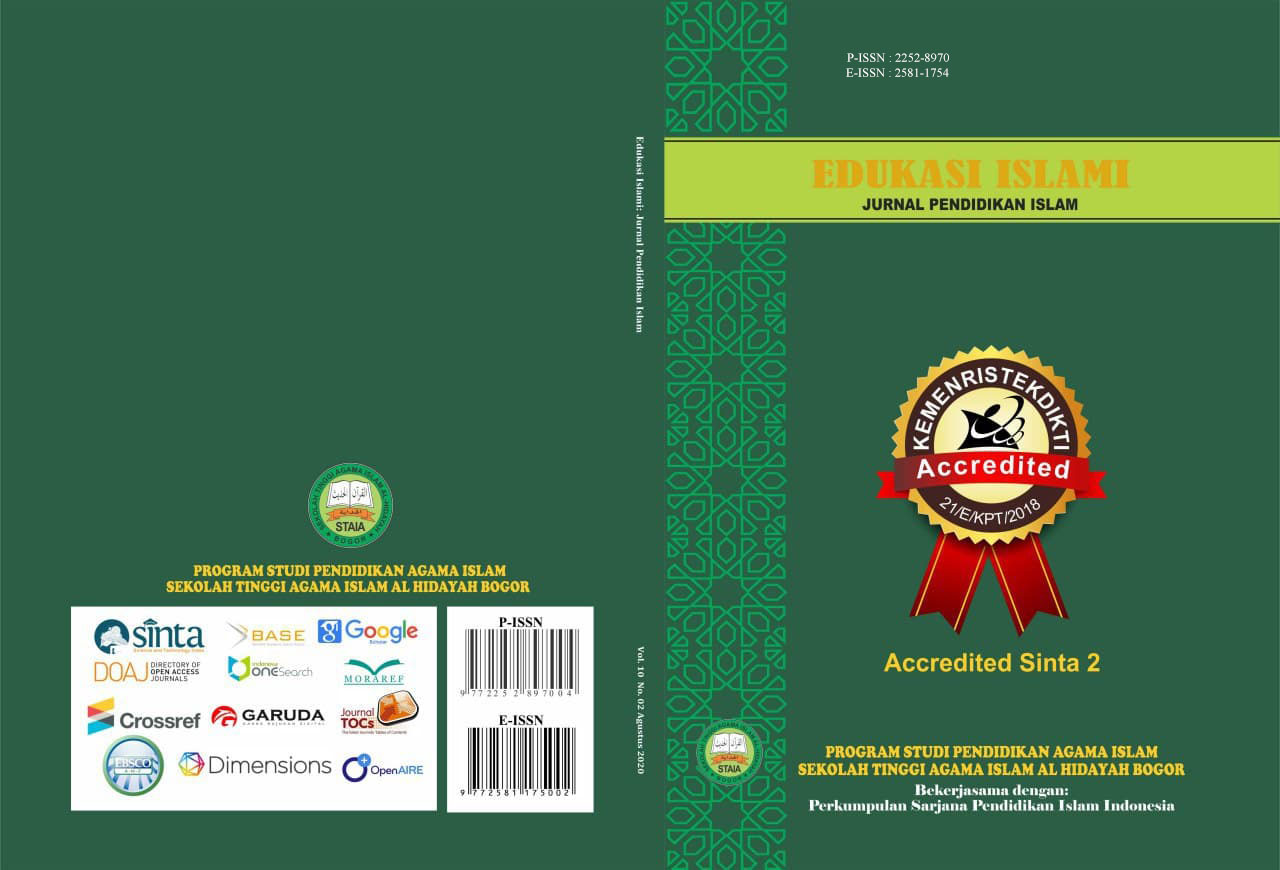PUNISHMENT RULES AND EXTRACURRICULAR ACTIVITIES ON THE DISCIPLINE AND CHARACTER BUILDING OF STUDENTS
DOI:
https://doi.org/10.30868/ei.v11i01.2816Keywords:
Punishment, Extracurricular Activities, Character Education.Abstract
References
Abacioglu, C. S., Fischer, A. H., & Volman, M. (2022). Professional development in multicultural education: What can we learn from the Australian context? Teaching and Teacher Education, 114, 103701. https://doi.org/10.1016/j.tate.2022.103701
Aburizaizah, S. J. (2022). The role of quality assurance in Saudi higher education institutions. International Journal of Educational Research Open, 3(January), 100127. https://doi.org/10.1016/j.ijedro.2022.100127
Ali, M. S., Kassahun, C. W., Wubneh, C. A., Mekonen, E. G., & Workneh, B. S. (2022). Applied nutritional investigation Determinants of undernutrition among private and public primary school children: A comparative cross-sectional study toward nutritional transition in northwest Ethiopia. Nutrition, 96, 111575. https://doi.org/10.1016/j.nut.2021.111575
Alvioli, M. (2020). Administrative boundaries and urban areas in Italy: A perspective from scaling laws. Landscape and Urban Planning, 204(July), 103906. https://doi.org/10.1016/j.landurbplan.2020.103906
Antonietti, C., Cattaneo, A., & Amenduni, F. (2022). Can teachers’ digital competence influence technology acceptance in vocational education? Computers in Human Behavior, 132(February), 107266. https://doi.org/10.1016/j.chb.2022.107266
Baczyński, M., Jayaram, B., & Mesiar, R. (2020). Fuzzy implications: alpha migrativity and generalised laws of importation. Information Sciences, 531. https://doi.org/10.1016/j.ins.2020.04.033
Bogren, M., Sathyanarayanan Doraiswamy, Erlandsson, K., Akhter, H., Akter, D., Begum, M., Chowdhury, M., Das, L., Akter, R., Begum, S., Akter, R., Yesmin, S., & Khatun, Y. A. (2018). Development of a context specific accreditation assessment tool for affirming quality midwifery education in Bangladesh. Midwifery, 61(November 2017). https://doi.org/10.1016/j.midw.2018.02.021
Chiu, P. H. P., Im, S. W. T., & Shek, C. H. (2022). Disciplinary variations in student perceptions of active learning classrooms. International Journal of Educational Research Open, 3(November 2021), 100131. https://doi.org/10.1016/j.ijedro.2022.100131
Colosi, E., Bassignana, G., Contreras, D. A., Poirier, C., Boëlle, P.-Y., Cauchemez, S., Yazdanpanah, Y., Lina, B., Fontanet, A., Barrat, A., & Colizza, V. (2022). Screening and vaccination against COVID-19 to minimise school closure: a modelling study. The Lancet Infectious Diseases, 3099(22). https://doi.org/10.1016/s1473-3099(22)00138-4
Dart, J., Ash, S., McCall, L., & Rees, C. (2022). ‘We’re our own worst enemies’: A qualitative exploration of sociocultural factors in dietetic education influencing student-dietitian transitions. Journal of the Academy of Nutrition and Dietetics. https://doi.org/10.1016/j.jand.2022.03.015
David L. Stader. (2013). Law And Ethics In Educational Leadership Southeast Missouri. United States.
Dias, C., Abdullah, M., Lovreglio, R., Sachchithanantham, S., Rekatheeban, M., & Sathyaprasad, I. M. S. (2022). Exploring home-to-school trip mode choices in Kandy, Sri Lanka. Journal of Transport Geography, 99(January), 103279. https://doi.org/10.1016/j.jtrangeo.2022.103279
Didham, R. J., & Ofei-Manu, P. (2020). Adaptive capacity as an educational goal to advance policy for integrating DRR into quality education for sustainable development. International Journal of Disaster Risk Reduction, 47(May 2019), 101631. https://doi.org/10.1016/j.ijdrr.2020.101631
Diestelmeier, L. (2019). Changing power: Shifting the role of electricity consumers with blockchain technology – Policy implications for EU electricity law. Energy Policy, 128(April 2018). https://doi.org/10.1016/j.enpol.2018.12.065
Dong, T., Eugster, F., & Nilsson, H. (2022). Business school education, motivation, and young adults’ stock market participation☆. Journal of Accounting and Public Policy, xxxx, 106958. https://doi.org/10.1016/j.jaccpubpol.2022.106958
Fabbri, C., Bhatia, A., Petzold, M., Jugder, M., Guedes, A., Cappa, C., & Devries, K. (2021). Modelling the effect of the COVID-19 pandemic on violent discipline against children. Child Abuse and Neglect, 116(P2), 104897. https://doi.org/10.1016/j.chiabu.2020.104897
Falch, T., Iversen, J. M. V., Nyhus, O. H., & Strøm, B. (2022). Quality measures in higher education: Norwegian evidence. Economics of Education Review, 87(February). https://doi.org/10.1016/j.econedurev.2022.102235
Frankenhuis, W. E., & Nettle, D. (2020). Integration of plasticity research across disciplines. Current Opinion in Behavioral Sciences, 36. https://doi.org/10.1016/j.cobeha.2020.10.012
Gardonio, P., & Dal Bo, L. (2020). Scaling laws of electromagnetic and piezoelectric seismic vibration energy harvesters built from discrete components. Journal of Sound and Vibration, 476, 115290. https://doi.org/10.1016/j.jsv.2020.115290
Gostin, L. O., Monahan, J. T., Kaldor, J., DeBartolo, M., Friedman, E. A., Gottschalk, K., Kim, S. C., Alwan, A., Binagwaho, A., Burci, G. L., Cabal, L., DeLand, K., Evans, T. G., Goosby, E., Hossain, S., Koh, H., Ooms, G., Roses Periago, M., Uprimny, R., & Yamin, A. E. (2019). The legal determinants of health: harnessing the power of law for global health and sustainable development. The Lancet, 393(10183), 1857–1910. https://doi.org/10.1016/S0140-6736(19)30233-8
Gulati, G., Cusack, A., Kelly, B. D., Kilcommins, S., & Dunne, C. P. (2020). Experiences of people with intellectual disabilities encountering law enforcement officials as the suspects of crime – A narrative systematic review. International Journal of Law and Psychiatry, 71(June), 101609. https://doi.org/10.1016/j.ijlp.2020.101609
Gulati, G., Kelly, B. D., Cusack, A., Kilcommins, S., & Dunne, C. P. (2020). The experience of law enforcement officers interfacing with suspects who have an intellectual disability – A systematic review. International Journal of Law and Psychiatry, 72(July), 101614. https://doi.org/10.1016/j.ijlp.2020.101614
Gullo, G. L., & Beachum, F. D. (2020). Principals navigating discipline decisions for social justice: An informed grounded theory study. Heliyon, 6(12), e05736. https://doi.org/10.1016/j.heliyon.2020.e05736
Harper, C. R., Johns, M. M., Orenstein, D., Pampati, S., Jones, T. M., Leonard, S., Taylor, K. R., & Robin, L. (2022). Association Between LGBTQ Student Nondiscrimination Laws in Selected States and School District Support for Gay-Straight Alliances. Journal of Adolescent Health, 70(4). https://doi.org/10.1016/j.jadohealth.2021.11.032
Hendrickson, B. (2018). Intercultural connectors: Explaining the influence of extra-curricular activities and tutor programs on international student friendship network development. International Journal of Intercultural Relations, 63(September 2017). https://doi.org/10.1016/j.ijintrel.2017.11.002
Jesry, M., Alhaj Omar, F., Rashwani, A., Bark, I., Jammo, K., Ajam, S., & Kassab, Z. (2022). Exploring the value of a risk-management quality-assurance model to support delivery of quality higher education in the conflict-affected northwest of Syria. International Journal of Educational Research Open, 3(February), 100134. https://doi.org/10.1016/j.ijedro.2022.100134
Komalasari K & saripuddin D. (2017). Pendidikan Karakter (Konsep dan Aplikasi Living Values Education. Refika Aditama.
Le, L. T. B., Tran, T. T., & Tran, N. H. (2021). Challenges to STEM education in Vietnamese high school contexts. Heliyon, 7(12), e08649. https://doi.org/10.1016/j.heliyon.2021.e08649
Lickona, T. (2013). Educating for Character, Terj. Juma Abdu Wamaungo. Bumi Aksara.
Lund, A. B., & Cyvin, J. (2022). Storyline in natural science teacher education - An approach to the coherence between theory and practice. International Journal of Educational Research Open, 3(February), 100104. https://doi.org/10.1016/j.ijedro.2021.100104
Mandic, S., GarcÃa Bengoechea, E., Hopkins, D., Coppell, K., & Spence, J. C. (2022). Adolescents’ perceptions of walking and cycling to school differ based on how far they live from school. Journal of Transport and Health, 24(January), 101316. https://doi.org/10.1016/j.jth.2021.101316
Morland, L. W., & Staroszczyk, R. (2020). A constitutive law for the viscous and tertiary creep responses of ice to applied stress. Cold Regions Science and Technology, 174(March), 103034. https://doi.org/10.1016/j.coldregions.2020.103034
Mukhtar, dkk. (2001). Sekolah Berprestasi. Nimas Multima.
Prins, S. J., Kajeepeta, S., Hatzenbuehler, M. L., Branas, C. C., Metsch, L. R., & Russell, S. T. (2022). School Health Predictors of the School-to-Prison Pipeline: Substance Use and Developmental Risk and Resilience Factors. Journal of Adolescent Health, 70(3). https://doi.org/10.1016/j.jadohealth.2021.09.032
Quinn, A., & Russo, A. (2022). Adaptive school grounds design in response to COVID-19: Findings from six primary schools in South East England. Building and Environment, 215(February), 108946. https://doi.org/10.1016/j.buildenv.2022.108946
Radtke, J. (2022). Smart energy systems beyond the age of COVID-19: Towards a new order of monitoring, disciplining and sanctioning energy behavior? Energy Research and Social Science, 84(October 2021). https://doi.org/10.1016/j.erss.2021.102355
Reijers, H. A. (2021). Business Process Management: The evolution of a discipline. Computers in Industry, 126, 103404. https://doi.org/10.1016/j.compind.2021.103404
Saltelli, A., Jakeman, A., Razavi, S., & Wu, Q. (2021). Sensitivity analysis: A discipline coming of age. Environmental Modelling and Software, 146(October), 105226. https://doi.org/10.1016/j.envsoft.2021.105226
Staupe-Delgado, R., Abdel-Fattah, D., & Pursiainen, C. (2022). A discipline without a name? Contrasting three fields dealing with hazards and disaster. International Journal of Disaster Risk Reduction, 70(October 2021), 102751. https://doi.org/10.1016/j.ijdrr.2021.102751
Suparlan. (2013). Manajemen Berbasis Sekolah dari Teori Sampai dengan Praktik. Bumi Aksara.
Sziklai, B. R. (2021). Ranking institutions within a discipline: The steep mountain of academic excellence. Journal of Informetrics, 15(2). https://doi.org/10.1016/j.joi.2021.101133
Takahashi, K., Ozawa, E., & Harizuka, S. (2020). Impact of corporal punishment on victims’ future violent behavior in extracurricular sports. Heliyon, 6(9), e04903. https://doi.org/10.1016/j.heliyon.2020.e04903
Theron, L., Ungar, M., & Höltge, J. (2022). Pathways of resilience: Predicting school engagement trajectories for South African adolescents living in a stressed environment. Contemporary Educational Psychology, 69. https://doi.org/10.1016/j.cedpsych.2022.102062
Thompson, G. L., McCombs, A., & Jansen, M. D. (2021). Relationships between consultant discipline and specified tree diversity: A case study of two Iowa (USA) communities. Urban Forestry and Urban Greening, 62(December 2020), 127183. https://doi.org/10.1016/j.ufug.2021.127183
Tiernan, P., & Deveci, Ä°. (2021). Irish and Turkish pre-service teachers understanding and perceptions of enterprise education. Heliyon, 7(7). https://doi.org/10.1016/j.heliyon.2021.e07591
U-Sayee, C. R., & Adomako, E. B. (2021). Supervisory practices and challenges faced by senior high school principals in Greater Monrovia, Liberia: implications for quality education. Heliyon, 7(4), e06895. https://doi.org/10.1016/j.heliyon.2021.e06895
Viinikainen, J., Bryson, A., Böckerman, P., Kari, J. T., Lehtimäki, T., Raitakari, O., Viikari, J., & Pehkonen, J. (2022). Does better education mitigate risky health behavior? A mendelian randomization study. Economics & Human Biology, 46(March 2021), 101134. https://doi.org/10.1016/j.ehb.2022.101134
Villiger, C., Hauri, S., Tettenborn, A., Hartmann, E., Näpflin, C., Hugener, I., & Niggli, A. (2019). Effectiveness of an extracurricular program for struggling readers: A comparative study with parent tutors and volunteer tutors. Learning and Instruction, 60(November 2018). https://doi.org/10.1016/j.learninstruc.2018.11.004
Wahjosumidjo. (2007). Kepemimpinan Kepala Sekolah. Raja Grafindo Persada.
Williams, G. C., Cole, A. G., de Groh, M., Jiang, Y., & Leatherdale, S. T. (2022). More support needed: Evaluating the impact of school e-cigarette prevention and cessation programs on e-cigarette initiation among a sample of Canadian secondary school students. Preventive Medicine, 155, 106924. https://doi.org/10.1016/j.ypmed.2021.106924
Yang, W. (2022). Artificial Intelligence education for young children: Why, what, and how in curriculum design and implementation. Computers and Education: Artificial Intelligence, 3, 100061. https://doi.org/10.1016/j.caeai.2022.100061
You, C. (2020). Law and policy of platform economy in China. Computer Law and Security Review, 39, 105493. https://doi.org/10.1016/j.clsr.2020.105493
Zhang, W., Henderson, C., Magnusdottir, E., Chen, W., Ma, N., Ma, H., & Thornicroft, G. (2022). Effect of a contact-based education intervention on reducing stigma among community health and care staff in Beijing, China: pilot randomized controlled study. Asian Journal of Psychiatry, 73(November 2021), 103096. https://doi.org/10.1016/j.ajp.2022.103096
Zhao, C. F., & Kruyt, N. P. (2020). An evolution law for fabric anisotropy and its application in micromechanical modelling of granular materials. International Journal of Solids and Structures, 196–197. https://doi.org/10.1016/j.ijsolstr.2020.04.007
Downloads
Published
Issue
Section
Citation Check
License
Authors who publish with this journal agree to the following terms:
- Authors retain copyright and grant the journal right of first publication with the work simultaneously licensed under a Creative Commons Attribution License that allows others to share the work with an acknowledgment of the work's authorship and initial publication in this journal.
- Authors are able to enter into separate, additional contractual arrangements for the non-exclusive distribution of the journal's published version of the work (e.g., post it to an institutional repository or publish it in a book), with an acknowledgment of its initial publication in this journal.
- Authors are permitted and encouraged to post their work online (e.g., in institutional repositories or on their website) prior to and during the submission process, as it can lead to productive exchanges, as well as earlier and greater citation of published work (See The Effect of Open Access).









